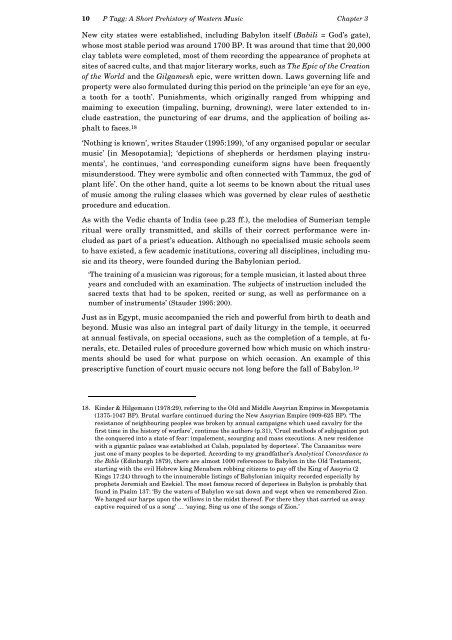A Short Prehistory of Western Music, Chapter 3
A Short Prehistory of Western Music, Chapter 3
A Short Prehistory of Western Music, Chapter 3
Create successful ePaper yourself
Turn your PDF publications into a flip-book with our unique Google optimized e-Paper software.
10 P Tagg: A <strong>Short</strong> <strong>Prehistory</strong> <strong>of</strong> <strong>Western</strong> <strong>Music</strong> <strong>Chapter</strong> 3<br />
New city states were established, including Babylon itself (Babili = God’s gate),<br />
whose most stable period was around 1700 BP. It was around that time that 20,000<br />
clay tablets were completed, most <strong>of</strong> them recording the appearance <strong>of</strong> prophets at<br />
sites <strong>of</strong> sacred cults, and that major literary works, such as The Epic <strong>of</strong> the Creation<br />
<strong>of</strong> the World and the Gilgamesh epic, were written down. Laws governing life and<br />
property were also formulated during this period on the principle ‘an eye for an eye,<br />
a tooth for a tooth’. Punishments, which originally ranged from whipping and<br />
maiming to execution (impaling, burning, drowning), were later extended to include<br />
castration, the puncturing <strong>of</strong> ear drums, and the application <strong>of</strong> boiling asphalt<br />
to faces. 18<br />
‘Nothing is known’, writes Stauder (1995:199), ‘<strong>of</strong> any organised popular or secular<br />
music’ [in Mesopotamia]; ‘depictions <strong>of</strong> shepherds or herdsmen playing instruments’,<br />
he continues, ‘and corresponding cuneiform signs have been frequently<br />
misunderstood. They were symbolic and <strong>of</strong>ten connected with Tammuz, the god <strong>of</strong><br />
plant life’. On the other hand, quite a lot seems to be known about the ritual uses<br />
<strong>of</strong> music among the ruling classes which was governed by clear rules <strong>of</strong> aesthetic<br />
procedure and education.<br />
As with the Vedic chants <strong>of</strong> India (see p.23 ff.), the melodies <strong>of</strong> Sumerian temple<br />
ritual were orally transmitted, and skills <strong>of</strong> their correct performance were included<br />
as part <strong>of</strong> a priest’s education. Although no specialised music schools seem<br />
to have existed, a few academic institutions, covering all disciplines, including music<br />
and its theory, were founded during the Babylonian period.<br />
‘The training <strong>of</strong> a musician was rigorous; for a temple musician, it lasted about three<br />
years and concluded with an examination. The subjects <strong>of</strong> instruction included the<br />
sacred texts that had to be spoken, recited or sung, as well as performance on a<br />
number <strong>of</strong> instruments’ (Stauder 1995:200).<br />
Just as in Egypt, music accompanied the rich and powerful from birth to death and<br />
beyond. <strong>Music</strong> was also an integral part <strong>of</strong> daily liturgy in the temple, it occurred<br />
at annual festivals, on special occasions, such as the completion <strong>of</strong> a temple, at funerals,<br />
etc. Detailed rules <strong>of</strong> procedure governed how which music on which instruments<br />
should be used for what purpose on which occasion. An example <strong>of</strong> this<br />
prescriptive function <strong>of</strong> court music occurs not long before the fall <strong>of</strong> Babylon. 19<br />
18. Kinder & Hilgemann (1978:29), referring to the Old and Middle Assyrian Empires in Mesopotamia<br />
(1375-1047 BP). Brutal warfare continued during the New Assyrian Empire (909-625 BP). ‘The<br />
resistance <strong>of</strong> neighbouring peoples was broken by annual campaigns which used cavalry for the<br />
first time in the history <strong>of</strong> warfare’, continue the authors (p.31), ‘Cruel methods <strong>of</strong> subjugation put<br />
the conquered into a state <strong>of</strong> fear: impalement, scourging and mass executions. A new residence<br />
with a gigantic palace was established at Calah, populated by deportees’. The Canaanites were<br />
just one <strong>of</strong> many peoples to be deported. According to my grandfather’s Analytical Concordance to<br />
the Bible (Edinburgh 1879), there are almost 1000 references to Babylon in the Old Testament,<br />
starting with the evil Hebrew king Menahem robbing citizens to pay <strong>of</strong>f the King <strong>of</strong> Assyria (2<br />
Kings 17:24) through to the innumerable listings <strong>of</strong> Babylonian iniquity recorded especially by<br />
prophets Jeremiah and Ezekiel. The most famous record <strong>of</strong> deportees in Babylon is probably that<br />
found in Psalm 137: ‘By the waters <strong>of</strong> Babylon we sat down and wept when we remembered Zion.<br />
We hanged our harps upon the willows in the midst there<strong>of</strong>. For there they that carried us away<br />
captive required <strong>of</strong> us a song’ … ‘saying, Sing us one <strong>of</strong> the songs <strong>of</strong> Zion.’














